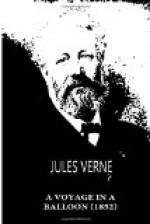A VOYAGE IN A BALLOON
by
JULES VERNE
Translated from the French by Anne T. Wilbur
1852
I.
My Ascension at Frankfort—The Balloon, the Gas, the Apparatus, the Ballast—An Unexpected Travelling Companion—Conversation in the Air—Anecdotes—At 800 Metres[A]—The Portfolio of the Pale Young Man—Pictures and Caricatures—Des Rosiers and d’Arlandes—At 1200 Metres—Atmospheric Phenomena—The Philosopher Charles—Systems—Blanchard—Guyton-Morveaux—M. Julien—M. Petin—At 1500 Metres—The Storm—Great Personages in Balloons—The Valve—The Curious Animals—The Aerial Ship—Game of Balloons.
[Footnote A: A metre is equal to 39.33 English inches.]
In the month of September, 1850, I arrived at Frankfort-on-the-Maine. My passage through the principal cities of Germany, had been brilliantly marked by aerostatic ascensions; but, up to this day, no inhabitant of the Confederation had accompanied me, and the successful experiments at Paris of Messrs. Green, Godard, and Poitevin, had failed to induce the grave Germans to attempt aerial voyages.
Meanwhile, hardly had the news of my approaching ascension circulated throughout Frankfort, than three persons of note asked the favour of accompanying me. Two days after, we were to ascend from the Place de la Comedie. I immediately occupied myself with the preparations. My balloon, of gigantic proportions, was of silk, coated with gutta percha, a substance not liable to injury from acids or gas, and of absolute impermeability. Some trifling rents were mended: the inevitable results of perilous descents.
The day of our ascension was that of the great fair of September, which attracts all the world to Frankfort. The apparatus for filling was composed of six hogsheads arranged around a large vat, hermetically sealed. The hydrogen gas, evolved by the contact of water with iron and sulphuric acid, passed from the first reservoirs to the second, and thence into the immense globe, which was thus gradually inflated. These preparations occupied all the morning, and about 11 o’clock, the balloon was three-quarters full; sufficiently so;—for as we rise, the atmospheric layers diminish in density, and the gas, confined within the aerostat, acquiring more elasticity, might otherwise burst its envelope. My calculations had furnished me with the exact measurement of gas required to carry my companions and myself to a considerable height.
We were to ascend at noon. It was truly a magnificent spectacle, that of the impatient crowd who thronged around the reserved enclosure, inundated the entire square and adjoining streets, and covered the neighbouring houses from the basements to the slated roofs. The high winds of past days had lulled, and an overpowering heat was radiating from an unclouded sky; not a breath animated the atmosphere. In such weather, one might descend in the very spot he had left.




